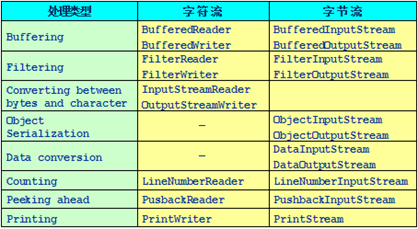流的作用:如何从能够发送字节序列的任何数据源取得输入,以及如何将输出发送到能够接收字节序列的任何目的地。即:输入/输出问题。
字节序列的源和目的地可以是文件、网络连接、内存块等,存储在文件中的信息和从网络连接中接收的信息,从本质上处理方法是相同的。
数据最终都保存为一个字节序列,但是在程序设计中应当用更高级的数据结构来处理,如字符或对象序列等。
java.io 包中定义了多个流类型(类或抽象类)来实现输入/输出功能;
可以从不同的角度对其进行分类:
按数据 流的方向 不同可以分为 输入流 和 输出流。(以程序的角度来考虑)
按处理数据 单位 不同可以分为 字节流 和 字符流。
按照 功能 不同可以分为 节点流 和 处理流。
J2SDK 所提供的所有流类型位于包java.io内都分别继承自以下四种抽象流类型。

节点流和处理流:
节点流为可以从一个特定的数据源(节点)读写数据(如:文件,内存)

处理流是“连接”在已存在的流(节点流或处理流)之上,通过对数据的处理为程序提供更为强大的读写功能。

InputStream
继承自InputSteam的流都是用于向程序中输入数据,且数据的单位为字节(8 bit);下图中深色为节点流,浅色为处理流。

InputStream的基本方法
读取一个字节并以整数的形式返回(0~255),
如果返回-1已到输入流的末尾。
int read() throws IOException
读取一系列字节并存储到一个数组buffer,
返回实际读取的字节数,如果读取前已到输入流的末尾返回-1
int read(byte[] buffer) throws IOException
读取length个字节并存储到一个字节数组buffer,从off位置开始存,最多len
返回实际读取的字节数,如果读取前以到输入流的末尾返回-1
int read(byte[] buffer, int off, int len)
throws IOException
关闭流释放内存资源
void close() throws IOException
OutputStream
继承自OutputSteam的流是用于程序中输入数据,且数据的单位为字节(8 bit);下图中深色为节点流,浅色为处理流。

OutputStream的基本方法
向输出流中写入一个字节数据,该字节数据为参数b的低8位
void write(int b) throws IOException
将一个字节类型的数组中的数据写入输出流
void write(byte[] b) throws IOException
将一个字节类型的数组中的从指定位置(off)开始的len个字节写入到输出流
void write(byte[] b, int off, int len)
throws IOException
关闭流释放内存资源
void close() throws IOException
将输出流中缓冲的数据全部写出到目的地
void flush() throws IOException
Reader
继承自Reader的流都是用于向程序中输入数据,且数据的单位为字符(16 bit);下图中深色为节点流,浅色的为处理流。

Reader 的基本方法
读取一个字符并以整数的形式返回(0~255),如果返回-1已到输入流的末尾。
int read() throws IOException
读取一系列字符并存储到一个数组buffer,返回实际读取的字符数,如果读取前已到输入流的末尾返回-1
int read(char[] cbuf) throws IOException
读取length个字符并存储到一个数组buffer,从off位置开始存,最多读取len返回实际读取的字符数,如果读取前以到输入流的末尾返回-1
int read(char[] cbuf, int off, int len)
throws IOException
关闭流释放内存资源
void close() throws IOException
Writer
继承自Writer的流都是用于程序中输入数据,且数据的单位为字符(16 bit);下图中深色为节点流,浅色为处理流。

Writer 的基本方法
向输出流中写入一个字符数据,该字节数据为参数b的低16位
void write(int c) throws IOException
将一个字符类型的数组中的数据写入输出流,
void write(char[] cbuf) throws IOException
将一个字符类型的数组中的从指定位置(offset)开始的length个字符写入到输出流
void write(char[] cbuf, int offset, int length)
throws IOException
将一个字符串中的字符写入到输出流
void write(String string) throws IOException
将一个字符串从offset开始的length个字符写入到输出流
void write(String string, int offset, int length)
throws IOException
关闭流释放内存资源
void close() throws IOException
将输出流中缓冲的数据全部写出到目的地
void flush() throws IOException
节点流类型

访问文件
FileInputStream和FileOutputStream分别继承自InputStream和OutputStream用于向文件中输入和输出字节。
FileInputStream和FileOutputStream的常用构造方法:
FileInputStream(String name) throws FileNotFoundException
FileInputStream(File file) throws FileNotFoundException
FileOutputStream(String name)throws FileNotFoundException
FileOutputStream(File file) throws FileNotFoundException
FileOutputStream(File file, boolean append)
throws FileNotFoundException
FileInputSteam 和 FileOutputStream 类支持其父类InputStream 和OutputStream 所提供的数据读写方法。
注意:
在实例化FileInputStream和FileOutputSteam流时要用try-catch语句以处理其可能抛出的FileNotFoundException。
在读写数据时也要用try-catch语句以处理可能抛出的 IOException。
FileNotFoundException是IOException的子类
FileReader 和 FileWriter 分别继承自Reader和Writer,FileInputSteam与FileOutputStream类似,所不同的是
FileReader和FileWriter向文件输入和输出的数据单位为字符。
FileReader和FileWriter的常用构造方法:
public FileWriter(File file) throws IOException
public FileWriter(File file, boolean append)
throws IOException
public FileWriter(String fileName)throws IOException
public FileWriter(String fileName,boolean append)
throws IOException
public FileReader(String fileName)
throws FileNotFoundException
public FileReader(File file)
throws FileNotFoundException
处理流类型

缓冲流
缓冲流要“套接”在相应的节点流之上,对读写的数据提供了缓冲的功能,提高了读写的效率,同时增加了一些新的方法。
J2SDK提供了四种缓存流,其常用的构造方法为:
BufferedReader(Reader in)
BufferedReader(Reader in,int sz) //sz 为自定义缓存区的大小
BufferedWriter(Writer out)
BufferedWriter(Writer out,int sz)
BufferedInputStream(InputStream in)
BufferedInputStream(InputStream in,int size)
BufferedOutputStream(OutputStream out)
BufferedOutputStream(OutputStream out,int size)
BufferedReader提供了readLine方法用于读取一行字符串(以\r或\n分隔)。
BufferedWriter提供了newLine用于写入一个行分隔符。
对于输出的缓冲流,写出的数据会先在内存中缓存,使用flush方法将会使内存中的数据立刻写出。
转换流
InputStreamReader和OutputStreamWriter用与字节数据到字符数据之间的转换。
InputStreamReader 需要和 InputStream “套接” 。
OutpStreamWriter 需要和 OutputStream “套接” 。
转换流在构造时可以指定其编码集合,例如:
InputStream isr = new InputStreamReader
(System.in, “ISO8859_1”)
数据流&ByteArrayInputStream&ByteArrayOutputStream
DataInputStream 和 DataOutputStream 分别继承自InputSteam 和 OutputStream,它属于处理流,需要分别“套接”在InputStream 和OutputStream类型的节点流上。
DataInputStream和DataOutputStream提供了可以存取与机器无关的Java原始类型数据(如:int,double 等)的方法。
DataInputStream和DataOutputStream的构造方法为:
DataInputStream ( InputStream in )
DataOutputStream ( OutputStream out )
Print 流
PrintWriter和PrintStream 都属于输出流,分别针对与字符和字节。
PrintWriter和PrintStream提供了重载的print
Println方法用于多种数据类型的输出。
PrintWriter和PrintStream的输出操作不会抛出异常,用户通过检测错误状态获取错误信息。
PrintWriter和PrintStream有自动flush功能。
PrintWriter(Writer out)
PrintWriter(Writer out,boolean autoFlush)
PrintWriter(OutputStream out)
PrintWriter(OutputStream out,boolean autoFlush)
PrintStream(OutputStream out)
PrintStream(OutputStream out,booleanautoFlush)
Object流
直接将Object写入或读出
transient关键字
serializable接口
Externalizable 接口
void writeExternal(ObjectOutput out) throws IOException
void readExternal(ObjectInput in) throws IOException, ClassNotFoundException
总结
InputStream/OutputStream //最基础的抽象类,字节流
Reader/Writer //最基础的抽象类 ,字符流
FileInputStream / FileOutputStream //File打头的用来操作文件,字节流
FileReader / FileWriter //File打头的用来操作文件,字符流
BufferedInputStream / BufferedOutputStream //带缓冲的,字节流
BufferedReader / BufferedWriter //带缓冲的,字符流
ByteArrayInputStream / ByteArrayOutputStream //读写内存中的字符数组
InputStreamReader / OutputStreamWriter //字节转字符,转化流
DataInputStream / DataOutputStream //读写基本数据类型
PrintStream / PrintWriter //都是输出流,不抛出异常,自动flush
ObjectInputStream / ObjectOutputStream //读写Object
Serializable接口标记性接口
Externalizable 自己控制序列化
Transient
posted on 2010-11-05 18:02
Mineralwasser 阅读(1179)
评论(1) 编辑 收藏